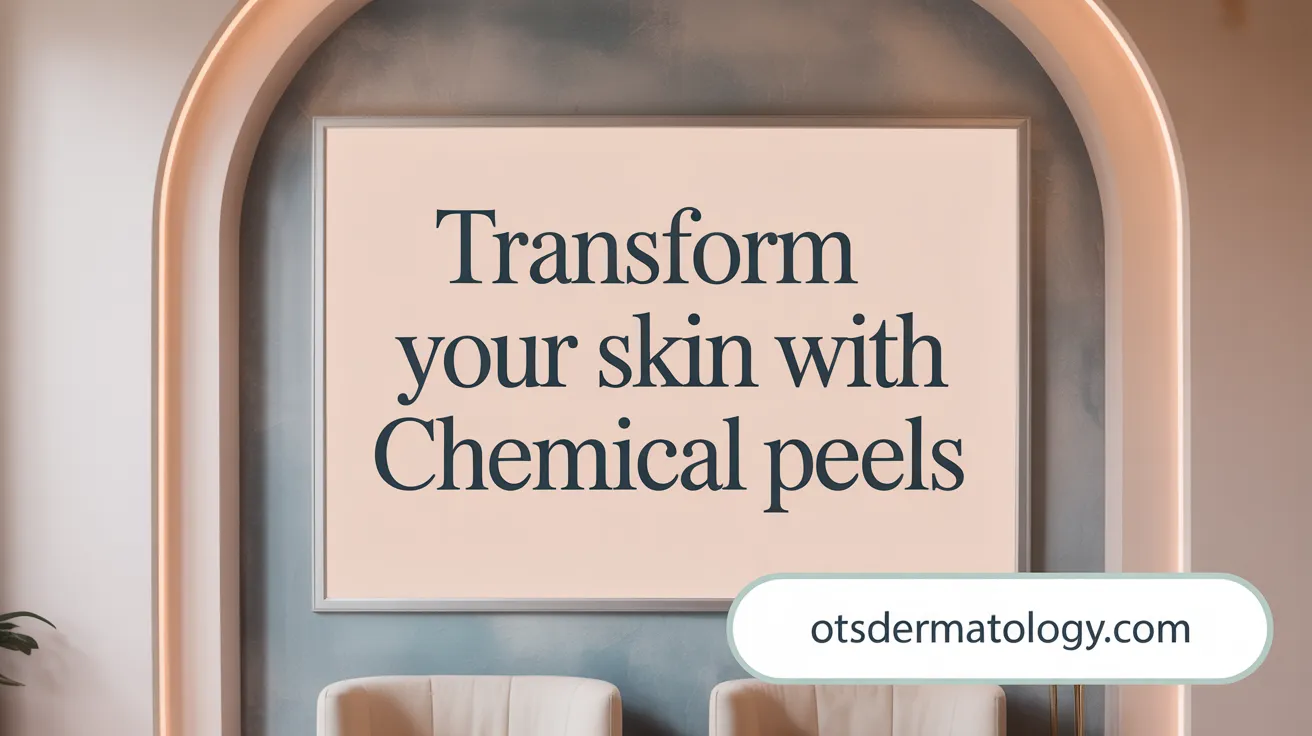Introduction to Modern Skin Rejuvenation Treatments
In the pursuit of rejuvenated skin, Hydrafacial, Microneedling, and Chemical Peels stand out as premier treatments that cater to varying skin needs and concerns. Each offers distinct mechanisms, benefits, and recovery expectations, making the choice dependent on individual skin types, goals, and lifestyles. This article explores these popular skin treatments in detail, helping readers make informed decisions toward optimal skin health and appearance.
Key Facts - Skin Rejuvenation Treatments
- Hydrafacial uses Vortex-Fusion technology involving cleansing, extraction, and serum infusion for instant skin hydration and glow.
- It is suitable for all skin types, including sensitive skin, with minimal to no downtime and customizable serums.
- Hydrafacial results last about 4-6 weeks, with regular treatments maintaining skin brightness and hydration.
- Microneedling creates controlled micro-injuries to stimulate collagen and elastin production for skin rejuvenation.
- Microneedling is effective for scars, wrinkles, enlarged pores, and uneven skin tone with low risk for all skin types.
- Chemical peels are categorized into superficial, medium, and deep, targeting different skin concerns with varied recovery times.
- Chemical peels work by exfoliating damaged skin layers to promote new, healthy skin growth and collagen production.
- Post-treatment, chemical peels may cause redness, peeling, and sensitivity, requiring sun protection and proper aftercare.
- Suitable candidates for chemical peels are determined by skin type and concern severity, with superficial peels being most broadly safe.
- Chemical peels can be combined with other treatments like microneedling or HydraFacial for enhanced overall skin rejuvenation.
1. Hydrafacial: Instant Glow with Deep Hydration and Cleansing

What is the Hydrafacial treatment process and technology?
Hydrafacial is a non-invasive multi-step facial treatment that uses proprietary Vortex-Fusion technology in HydraFacial. This process involves three main phases: deep cleansing and exfoliation to remove dead skin cells, vortex-powered extraction to clear clogged pores, and hydration through infusion of serums rich in antioxidants, peptides, and hyaluronic acid to nourish the skin.
Is Hydrafacial suitable for all skin types, including sensitive skin?
Yes. Hydrafacial is suitable for all skin types, including sensitive skin. It is gentle and customizable, designed to address individual skin needs without causing irritation. See more about Benefits for all skin types.
What are the immediate results and downtime associated with Hydrafacial?
One of the significant advantages of Hydrafacial is its immediate visible results. After a session, skin appears brighter, more hydrated, and clearer, with improved tone and texture. There is minimal to no downtime; most patients resume regular activities immediately, with only occasional mild redness or tightness that resolves quickly. Learn about Immediate results with HydraFacial.
How is Hydrafacial customized through serums and boosters?
Hydrafacial treatments can be personalized by selecting specific serums and boosters tailored to individual concerns. For example, serums targeting acne, fine lines, pigmentation, or dryness can be infused during the procedure. Some options include antioxidant-rich formulas and skin-plumping peptides. Additional treatments like LED therapy can be added for enhanced skin rejuvenation. See Personalized Hydrafacial treatments and LED therapy benefits.
What benefits does Hydrafacial offer for various skin concerns?
Hydrafacial effectively improves skin hydration, making it particularly beneficial for dry skin. It clears pores, which helps manage acne and reduces breakouts without irritation. The exfoliation and serum infusion support the reduction of fine lines and wrinkles and diminish hyperpigmentation and uneven skin tone. It also addresses enlarged pores and boosts overall skin radiance. Learn more about HydraFacial treatment benefits.
How long do Hydrafacial results last and what about maintenance?
Results from a Hydrafacial typically last about four to six weeks. For sustained benefits, regular monthly treatments are recommended. Consistent maintenance helps improve skin health over time, keeping the skin glowing, hydrated, and balanced. For more information, see HydraFacial benefits duration.
What safety considerations and side effects should be known?
Hydrafacial is generally safe with a low risk of adverse effects. Mild temporary redness, tingling, or skin tightness may occur but usually resolves within a day or two. The treatment increases sun sensitivity, so applying broad-spectrum SPF 30 or higher is recommended following sessions. People with active skin infections or irritation should avoid treatment until healed. Reference HydraFacial safety and side effects for additional details.
Overall, Hydrafacial is a soothing, effective facial treatment that provides immediate skin rejuvenation with minimal discomfort, making it a popular choice for a radiant, refreshed complexion suitable for a range of skin types and concerns.
2. Microneedling: Stimulating Collagen for Long-Term Skin Renewal

What is Microneedling and How is the Procedure Performed?
Microneedling, also known as collagen induction therapy, is a minimally invasive dermatological treatment. It involves using a device equipped with fine, tiny needles to create controlled micro-injuries on the skin surface. These micro-punctures stimulate the body’s natural wound healing response, prompting production of collagen and elastin — two key proteins essential for firm, youthful skin.
The procedure typically takes about 30 to 60 minutes depending on the treated area and involves skin preparation, the microneedling itself, and post-treatment care. Devices used range from manual rollers to automated pens, with variations such as radiofrequency microneedling offering deeper stimulation.
How Does Microneedling Stimulate Collagen and Elastin Production?
By creating microscopic injuries, microneedling activates growth factors and inflammatory responses that signal skin cells to repair tissue. This healing process increases collagen and elastin production, leading to improved skin texture, elasticity, and thickness over time. These effects help reduce wrinkles, scars, and skin laxity.
What Skin Concerns Does Microneedling Effectively Treat?
Microneedling is effective for:
- Acne scars and surgical scars
- Fine lines and wrinkles
- Hyperpigmentation and sun damage
- Enlarged pores
- Uneven skin tone and texture
- Stretch marks
It can be used on various body parts but is most commonly applied to the face.
Is Microneedling Suitable for All Skin Types?
Yes, microneedling is generally safe for all skin types, including darker tones. Unlike some chemical peels and laser treatments, it carries a low risk of hyperpigmentation in darker skin due to its mechanical rather than chemical or thermal action.
How Does Combining Microneedling with Platelet-Rich Plasma (PRP) Enhance Results?
PRP uses concentrated growth factors derived from the patient’s own blood, which can be applied to the skin post-microneedling. This combination accelerates healing, further stimulates collagen synthesis, and enhances the benefits for scars, pigmentation, and overall skin rejuvenation. Learn more about the benefits of microneedling with PRP.
What is the Recovery Time and Typical Side Effects?
Post-treatment, patients may experience redness, swelling, and mild discomfort resembling a sunburn. These effects typically resolve within 1 to 4 days. Some peeling or dryness can occur but usually is minimal.
How Many Sessions Are Required and When Do Results Appear?
Multiple sessions—often 3 to 6 spaced 4 to 8 weeks apart—are recommended to achieve optimal results. Visible improvements usually start within 3 months as collagen remodeling progresses, with benefits lasting several months after treatment completion.
How Does Microneedling Compare to Other Treatments Like Laser and Chemical Peels?
Microneedling offers a less invasive alternative to laser resurfacing and deep chemical peels, with shorter downtime and fewer risks, especially for darker skin tones. It reaches deeper skin layers than chemical peels and promotes natural collagen regeneration, whereas chemical peels are primarily surface exfoliants. Laser treatments can provide dramatic resurfacing but carry higher risks and recovery time.
Overall, microneedling is a versatile and effective modality for long-term skin renewal, improving both superficial texture and deeper structural problems through collagen induction. For more detailed comparisons, see Microneedling vs. Chemical Peels and Microneedling vs. HydraFacial.
3. Chemical Peels: Customized Exfoliation for Targeted Skin Renewal

What Types of Chemical Peels Are Available?
Chemical peels are categorized into three main types based on their depth of action on the skin:
-
Superficial Peels: These peels use mild acids like glycolic or lactic acid and affect only the outermost epidermis. They are ideal for mild skin issues such as fine wrinkles, uneven skin tone, and dryness (Superficial Chemical Peels, Superficial Chemical Peel).
-
Medium Peels: These reach the superficial dermis, commonly using trichloroacetic acid (TCA). They treat moderate wrinkles, acne scars, and uneven pigmentation (Medium Chemical Peels, TCA Peels Medium-Depth Exfoliation).
-
Deep Peels: Using strong agents like phenol, deep peels penetrate the lower dermis and are suited for severe wrinkles, deep scars, and precancerous skin lesions (Deep Chemical Peels, Chemical Peels for Wrinkles.
How Do Chemical Peels Work?
Chemical peels apply a chemical solution to controlledly exfoliate and remove damaged layers of skin. This process stimulates the body's natural healing response, promoting the growth of new, healthy skin cells and increased collagen production. The result is smoother, more youthful-looking skin with improved texture and tone (Chemical Peel Overview, Benefits of Chemical Peels).
What Skin Concerns Can Chemical Peels Address?
Chemical peels effectively target various skin conditions, including:
- Wrinkles and fine lines (Chemical Peels for Wrinkles
- Acne scars and surgical scars (Acne Scars Treatment with Chemical Peels)
- Hyperpigmentation, sun damage, age spots, and melasma (Chemical Peels for Sun Damage and Aging, Cosmelan Peel for Hyperpigmentation
- Uneven skin tone and texture (Chemical Peels for Uneven Skin Texture)
- Enlarged pores (Chemical Peels Shrinking Pore Size)
What Is the Recovery Process and Potential Side Effects?
The recovery time and side effects depend on the peel type:
| Peel Type | Recovery Time | Common Side Effects |
|---|---|---|
| Superficial | 1-7 days | Mild redness, dryness, slight peeling (Chemical Peel Recovery) |
| Medium | 7-14 days | Redness, swelling, peeling, sensitivity to sunlight (Medium Chemical Peel Recovery |
| Deep | 2-3 weeks | Intense redness, swelling, crusting, longer sun sensitivity (Deep Chemical Peel Effects |
Post-treatment care is crucial and includes avoiding sun exposure, wearing broad-spectrum sunscreen (SPF 30 or higher), moisturizing, and not picking at peeling skin to avoid complications (Chemical Peel Post-Treatment Care, Sun Protection After Chemical Peels).
Who Is Suitable for Chemical Peels?
Suitability depends on skin type, tone, and the severity of concerns. Superficial peels are generally safe for all skin types, but medium and deep peels require careful consideration, especially for darker skin tones due to risks of discoloration (Chemical Peels for Sensitive Skin, Chemical Peel Risks for Dark Skin). Consulting a dermatologist allows for customized treatment planning to minimize risks (Personalized Skincare Treatment Plans.
Can Chemical Peels Be Combined with Other Treatments?
Yes. Chemical peels can be part of a multimodal approach to skin rejuvenation. For example, they are often combined with microneedling or HydraFacial treatments to target different layers and concerns, enhancing overall skin health and appearance (Combining Microneedling and Chemical Peels, HydraFacial and Chemical Peels Comparison).
What About Cost and Customization?
The cost of chemical peels varies widely based on peel depth and formulation, ranging from $80 for superficial peels up to $1,000 or more for deep peels (Cost of Chemical Peels, Pricing Comparison: HydraFacial vs Chemical Peels. Treatments can be tailored to individual skin needs during consultation, choosing appropriate acids and concentrations (Customizing Chemical Peels.
How Important Is Post-Treatment Care?
Aftercare is vital to maximize results and protect newly revealed skin. Strict sun protection, gentle skincare, hydration, and avoiding irritants help promote healing and prevent complications like hyperpigmentation or scarring (Chemical Peel Aftercare Guidelines, Sun Protection After Chemical Peels.
By understanding the types, mechanisms, and care associated with chemical peels, individuals can make informed decisions about their skin rejuvenation options.
Choosing the Right Treatment for Your Skin Goals
Selecting between Hydrafacial, Microneedling, and Chemical Peels depends on your skin’s unique needs, concerns, and your lifestyle preferences. Hydrafacial offers a gentle, non-invasive option with immediate results and is well-suited for those seeking hydration, pore cleansing, and a quick glow with no downtime. Microneedling stands out for its ability to stimulate deeper collagen and elastin production, making it effective for reducing scars, wrinkles, and improving textured skin over time, though it requires multiple sessions and brief recovery. Chemical Peels provide customizable exfoliation depth to treat a wide spectrum of skin concerns, delivering more dramatic, longer-lasting results but often with significant recovery time. Consulting a board-certified dermatologist ensures personalized treatment planning, often combining these modalities for enhanced skin rejuvenation outcomes. Ultimately, understanding the unique strengths of each helps you achieve the best results for radiant, healthy skin.
